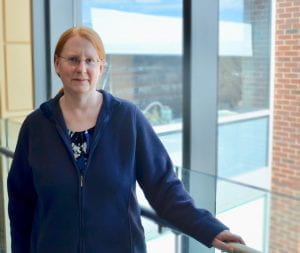 Dr. Christine Keating
Dr. Christine Keating
Shapiro Professor of Chemistry
Department: Chemistry
College: Eberly College of Science
Address: 512 Chemistry Building
Phone: 814-863-7832
E-mail: cmd8@psu.edu
Website: https://sites.psu.edu/keatinggroup/
Artificial Coral
This project develops coral-inspired artificial cells and studies the interactions between these artificial hosts and living algae. Coral reefs are the accumulated mineral skeletons of living coral organisms. Their color comes from symbiotic algae that live inside the corals and are important to their survival –coral bleaching is the loss of these internalized algae. Improved basic understanding of coral-algae symbioses is needed to predict and combat the effects of climate change on coral reefs and associated fisheries, but the complexity of living symbiotic systems complicates study. The Artificial Corals developed by this project serve as simple, nonliving model “organisms” for beginning to dissect the biological chemistry of the coral-algae relationship. Two types of artificial coral cells designed to capture key functions of this organism are being constructed by bottom-up assembly from nonliving molecular parts. The first, inspired by coral’s oral gastroderm cells, is designed to participate in a symbiotic relationship with living dinoflagellate algae. The second is designed to deposit mineral skeletons, as do the coral calicoblastic cells. These nonliving Artificial Coral cells provide a new platform for probing crucial aspects of the coral-algae mutualism responsible for coral reefs by greatly simplifying host biochemistry. Strategies for artificial endosymbiosis being developed in this work could provide guidance for future symbiont-focused reef interventions aimed at assisting coral survival. More broadly, the project also advances understanding of how local pH and inorganic carbon speciation can be controlled in artificial cells without requiring active membrane transport. Such control is crucial to countless cellular processes, and the membrane-free routes to be developed here should be adoptable for other bottom-up synthetic cells.
Astrobiology: Prebiotic Compartmentalization
Imagine if you will a primordial soup in which abiotic chemical synthesis is occurring, leading to oligomerization and polymerization of molecules that will eventually become biopolymers. Some tiny fraction of the nascent biopolymers acquire functions such as the ability to fold into secondary and tertiary structures able to catalyze reactions. How can these rare proto-biopolymers be collected together into compartments that would eventually become protocells? Associative phase separation, also called coacervation, of aqueous macromolecules to form dense, polymer-rich phase droplets could provide a simple physical mechanism to accumulate and concentrate functional molecules such as RNAs or their molecular progenitors. We explore this possibility with an emphasis on the molecular composition and physicochemical properties of the phase-separating systems, and their impact on accumulated molecules such as RNAs. We collaborate with the Bevilacqua lab on RNA structure and function in the coacervates.
Synthetic Cells and Organelles
Chemists have always learned by synthesis. Historically, chemists prepared metallic alloys and later organic molecules, varying the synthetic procedure to better understand the properties of the resulting materials. We carry on this tradition by using the tools of molecular self-assembly and the behavior of thermodynamically nonideal polymer solutions to construct primitive models of biological cells, organelles, and cell-like environments. These systems then become test beds for evaluating hypotheses about how cells work and how the earliest cells may have evolved. Motivations for this work range from basic to applied science; by asking how intracellular structure leads to function we hope to learn not only about how cells function but also to find routes to preparing new, nonbiological materials for desired functions. Examples of the latter include potential medical applications in drug delivery or inorganic/organic composite materials with improved optical or mechanical properties.
